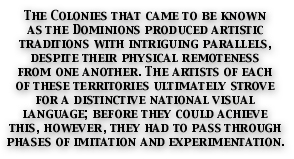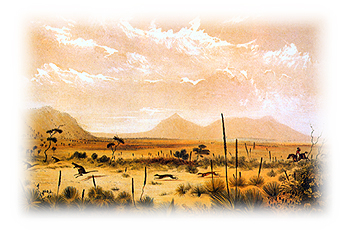|
From the early 1790s, convict and free artists depicted Australia as a land Europeans could find perfectly sympathetic. Lachlan Macquarie, the influential Governor of New South Wales from 1810 to 1821, encouraged the building of Georgian architecture and the artists painted the grander houses in their almost English parkland. Here was a tamed and elegant landscape on the fringes of a vast, unfamiliar, and remote continent.
The discovery of gold in Australia in the mid-Nineteenth Century galvanized the economic life and rate of settlement of Europeans and quickly introduced artists to new interior landscapes, to fresh social contexts, and to characteristic colonial types - the Diggers and other inhabitants of the gold-rush townships. Aborigines attracted relatively little interest from European painters - they were sometimes included as decorative figures in lancscapes. However, in the late Nineteenth Century, when it was commonly supposed that Aborigines were a dying race, portrait studies of individuals were seen as 'historical documents' of a people who disappearing forever.
Ironically, Australian art only aspired to be truly Australian once it was influenced by artists who had been trained abroad. In the late 1880s and 1890s a group of artists established the Heidelberg school on the outskirts of Melbourne. They introduced impressionist principles, attempting to portray the higher, brighter tones of the natural light of Australia and to render the design and colouring of the eucalyptus tree; they also emphasized the dignity of the lives of ordinary people. With their art, an Australia national school and a recognizably appropriate and distinctive landscape style had come of age.
Australian art found more successful national vehicles when it set out to blend the starkly opalescent hues of its environment with the rediscovery of the art of its indigenous peoples. A new school of Australian painters, of whom Sir Sidney Nolan is the best known, set about juxtaposing symbols of European material life with antipodean landscapes and indigenous motifs, mostly conveyed in the shrill colours of the Australian interior. Some of these painters have also attempted to present a colonial past as dominated by resistance. Nolan, for example, has done this through his sequence of paintings of the Ned Kelly Legend.
|


